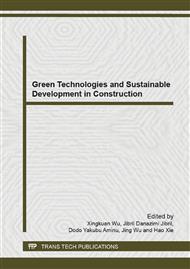[1]
B. Givoni, Man, climate and architecture, Publisher, City, (1969).
Google Scholar
[2]
A.S. Muhaisen, Shading simulation of the courtyard form in different climatic regions, Publisher, City, (2006).
Google Scholar
[3]
T. Callaway, Human Shelter in Arid Zones, Publisher, City, (1980).
Google Scholar
[4]
M.A. Kamal, AN ASSESSMENT OF CLIMATIC DESIGN STRATEGY FOR LOW ENERGY RESIDENTIAL BUILDINGS IN HOT AND ARID CLIMATE, Publisher, City, (2013).
Google Scholar
[5]
S. Berkovic, A. Yezioro, A. Bitan, Study of thermal comfort in courtyards in a hot arid climate, Publisher, City, (2012).
DOI: 10.1016/j.solener.2012.01.010
Google Scholar
[6]
M. Thirugnanasambandam, S. Iniyan, R. Goic, A review of solar thermal technologies, Publisher, City, (2010).
Google Scholar
[7]
S.B. Sadineni, S. Madala, R.F. Boehm, Passive building energy savings: A review of building envelope components, Publisher, City, (2011).
DOI: 10.1016/j.rser.2011.07.014
Google Scholar
[8]
R. Sairam, P. Raviteja, A. Naresh, Case Study: Performance Assessment of Various Sun Shades for Hot-Dry Climate, Publisher, City, (2013).
DOI: 10.4028/www.scientific.net/amr.816-817.875
Google Scholar
[9]
A.S. Muhaisen, H.M. Abed, Investigation of the Thermal Performance of Building Form in the Mediterranean Climate of the Gaza Strip, Publisher, City, (2013).
Google Scholar
[10]
M.A. Mohsen, Solar radiation and courtyard house forms II: Application of the model, Publisher, City, (1979).
Google Scholar
[11]
J. Reynolds, Courtyards: aesthetic, social, and thermal delight, Wiley, (2002).
Google Scholar
[12]
J. Cook, Passive cooling, in, Arizona State Univ., Tempe, AZ (USA), (1989).
Google Scholar
[13]
A.S. Muhaisen, M. B Gadi, Shading performance of polygonal courtyard forms, Publisher, City, (2006).
DOI: 10.1016/j.buildenv.2005.04.027
Google Scholar
[14]
M.F. Agha, The concern of microclimate and comfort zone as generator for the courtyard house design with particular emphasis on the hot-arid zone, in, Graduate School of Arts and Sciences, University of Pennsylvania, (1975).
Google Scholar
[15]
D. Macintosh, The Modern Courtyard House: A History, Lund Humphries for the Architectural Association, (1973).
Google Scholar
[16]
C.H. AD, A. Al-Shahi, The Arab House: Colloquium: Papers, University of Newcastle, CARDO, (1986).
Google Scholar
[17]
M.H. Ahmad, R.O. Dilshan, S.L. Chia, Impact of solar radiation on high-rise built form in tropical climate, Publisher, City, (2004).
Google Scholar


